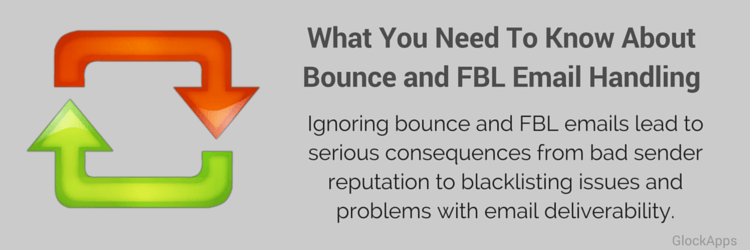3 Things You Need To Know About Bounced Emails and FBL Email Handling

Handling of bounce emails and feedback loops is a part of best email marketing practices. And there is a solid ground for this. Ignoring bounce and FBL emails lead to serious consequences from bad sender reputation to blacklisting issues and problems with email deliverability.
Thus, bounce and FBL loops handling is a must-have aspect of email marketing. As a rule, big email service providers like MailChimp have bounce and FBL loops handling as a feature. Marketers who are using in-house email systems should set up the bounce and FBL handling process themselves either by using a built-in tool in their email marketing system or by using a 3rd party tool.
To help you decide on the best bounce and FBL loops handling method, we’ve put together the most important (in most cases hidden) things you should know about bounce emails and feedback loops. Check them below:
#1. Changing bounce rules are a real challenge.
The receiving mail server at an ISP generates a bounce code when a message can’t be delivered due to an invalid email address or other reason. Each receiving domain implements differing rules for bouncing messages.
For example, some receiving domains bounce messages back if the recipient is invalid during the SMTP transaction while others send a bounce after the transaction is complete.
Each domain has many reasons for bouncing or deferring a message. The problem is that though the SMTP standards governing email sending and receiving over the Internet do establish bounce codes and their meanings, in reality, there is no common standard for bounce codes, and each receiver uses its own variation.
Thus, the bounce codes and reasons for the bounce can differ between receiving domains and present a challenge to senders.
Some ISPs publish their bounce rules and codes to help senders manage their bounce emails effectively. Others don’t disclose the bounce rules at all. Some ISPs change their rules frequently, others don’t.
With 12,000+ ISPs worldwide and millions of receiving domains, it’s very difficult for senders to keep track of all bounce rules worldwide and continually tweak their bounce processing system to reflect the recent changes.
#2. FBL email processing is a complicated task.
Feedback loop emails are machine generated messages when a recipient marks a message as spam. A lot of ISPs support the feedback loop service that allows the senders to sign up and receive FBL emails. Most ISPs send FBL messages in a standard Abuse Reporting Format (ARF).
Just like bounce codes, the FBL report format and content varies from ISP to ISP, making the processing of FBL emails a complicated and time-consuming task.
Open source MTAs were originally designed for small email applications and have little or no functionality for processing FBL emails, at best providing a mechanism for routing them to a dedicated folder or mailbox.
If the sender wants to automate FBL email handling, it would require building and maintaining a custom application to interpret and handle all the FBL messages.
#3. Bounce and FBL email processing involves an expensive hidden cost.
For a small company with a relatively low number of email recipients, programming a simple code to handle common bounce and FBL policies might not be a heavy lift. As far as a sender’s subscriber base grows, the number of receiving domains and the number of bounce codes increases exponentially.
So, for mid-size and large senders, and any organization managing multiple sending servers and domains managing bounces and FBL emails effectively can become highly complex.
In fact, continually tweaking/updating the sending infrastructure to meet evolving ISP rules requires significant engineering resources, time, and cost.
The bottom line:
Obviously, bounce and FBL email handling are complicated technical email processes that marketers would prefer to run automatically. But every email marketer making a bounce handling decision should have a basic understanding about bounce emails because getting bounce and FBL handling in the wrong way can be a very expensive mistake.
But with intelligent automated bounce and FBL handling, you can reduce your email marketing costs and optimize the value of your email campaigns.



